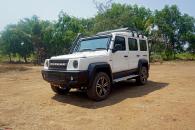News
Test drove the BYD Seal & Ioniq 5 together: 10 quick observations
One area where Ionic 5 knocks BYD Seal out of the park is the regenerative breaking. After driving most of the EV’s in this segment, I can confidently say that Hyundai/Kia group have the best regen system in the industry.
BHPian chohan recently shared this with other enthusiasts.
I test drove BYD seal (Performance AWD)
Comparison with Hyundai Ioniq 5:
- Areas where BYD Seal scores over Hyundai ionic 5
- The driver cockpit cocoons you in a typical sedan-like fashion. For a sedan lover like me, it’s instantly appealing. While I wouldn’t say the interior elements are plusher than the Ioniq 5, the overall dark interiors with alcantara touches on the dash create a cozy vibe.
- The heads up display boasts impressive quality and has a nice projection
- While driving, the rear of the car isn’t as bouncy as the Ionic 5, perhaps it is a sedan trait. I haven’t driven the car at highway speeds but it should easily have better high speed dynamics owing to its shape and body style.
Areas where ionic 5 scores over BYD seal:
Sense of space: Besides the real difference in legroom, headroom and shoulder room, the overall sense of space is akin to the difference between a deluxe room and a suite. Although I personally prefer dark interiors, the feeling of spaciousness with the light interior in the Ioniq 5 has been a revelation.
Rear seat comfort: We all know that rear seat tuning is an engineering challenge for electric cars because of the battery pack sitting underneath. While both the cars have similar or lack of under thigh support, the Ionic 5 solves some part of that problem with the recline option on the rear seats. Reclining the seats is one way to attain that missing under thigh support.
Ride at city speeds: While I took a small test drive at city speeds. I felt the ride in BYD Seal has some firmness and road noise crept in more than the Ioniq 5. Hyundai on the other hand has a plusher ride while still having that underlying firmness of an electric car. However those massive 20 inch wheels take away some part of the plushness but still the ride quality i would prefer at city speeds.
Practicality: I have been a proponent of saloon body style since I owned my first car. From Linea T-jet to Skoda Octavia to BMW 3 series, it’s been all sedan for me but after clocking 15 thousand kilometres in Ioniq 5 over the past year, I can say that it’s difficult to beat the practicality of an SUV body style. The enhanced ground clearance and rear hatch let me do stuff I had never done in a Sedan.
The GAME CHANGER: One area where Ionic 5 knocks BYD Seal out of the park is the regenerative breaking. After driving most of the EV’s in this segment, I can confidently say that Hyundai/Kia group have the best regen system in the industry. From my short interaction with the BYD seal and explanation from the dealership agent, I believe that BYD seal has only two levels of regeneration which have to be activated from the screen while Ioniq 5 has pedal shifters on the steering wheel. There are limited avenues in an EV that let the driver customise his driving experience and flexible regenerative breaking is one of them. The level of customisation in Ionic 5 is exhaustive. Hell, even auto regen setting has different levels from mild auto to strong auto. Then the pedals to change to level 1,2 and 3 on the fly and then holding the left pedal to invoke maximum regen for as long as you hold it( like brake pedal) .I still believe there has to be more to the regenerative braking system of the BYD seal other than two simple settings. If someone has detailed knowledge should clear the doubt.
Additional observations:
- Throttle modulation is very similar to Ioniq 5’s. Both build speed gradually and lack outright punch.
- It’s very hard to believe this car could do 0-100 in under four seconds. Initial response from throttle is slow.
- Front doors are chunkier and have better thud in Ioniq 5.
- The rear of BYD Seal doesn’t bounce on speed breakers as much as Ioniq 5.
- Lack of heated rear seats is a bummer for north India. Folks have ridiculed Hyundai for providing heated rear seats in Ioniq 5 instead of ventilated seats but they miss the point. Heated seats is a way to reduce the usage of hot blower in winter. The difference is energy consumption is mind boggling. You could run heated seats all day with minimal impact on battery but the blower on other hand will suck battery like a maniac. I have used heated seats without feeling the need to use blower all winter. Thumbs up for this feature!
I will have another detailed test drive of BYD Seal as it’s hard to escape the sedan bug.
Read BHPian comments for more insights and information.


















